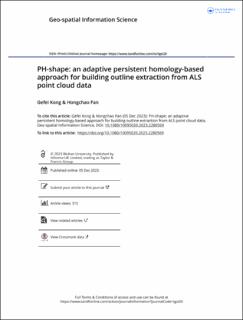| dc.contributor.author | Kong, Gefei | |
| dc.contributor.author | Fan, Hongchao | |
| dc.date.accessioned | 2024-01-17T13:48:29Z | |
| dc.date.available | 2024-01-17T13:48:29Z | |
| dc.date.created | 2024-01-02T13:00:18Z | |
| dc.date.issued | 2023 | |
| dc.identifier.citation | Geo-spatial Information Science. 2023, . | en_US |
| dc.identifier.issn | 1009-5020 | |
| dc.identifier.uri | https://hdl.handle.net/11250/3112246 | |
| dc.description.abstract | Building outline extraction from segmented point clouds is a critical step of building footprint generation. Existing methods for this task are often based on the convex hull and α-shape algorithm. There are also some methods using grids and Delaunay triangulation. The common challenge of these methods is the determination of proper parameters. While deep learning-based methods have shown promise in reducing the impact and dependence on parameter selection, their reliance on datasets with ground truth information limits the generalization of these methods. In this study, a novel unsupervised approach, called PH-shape, is proposed to address the aforementioned challenge. The methods of Persistence Homology (PH) and Fourier descriptor are introduced into the task of building outline extraction. The PH from the theory of topological data analysis supports the automatic and adaptive determination of proper buffer radius, thus enabling the parameter-adaptive extraction of building outlines through buffering and “inverse” buffering. The quantitative and qualitative experiment results on two datasets with different point densities demonstrate the effectiveness of the proposed approach in the face of various building types, interior boundaries, and the density variation in the point cloud data of one building. The PH-supported parameter adaptivity helps the proposed approach overcome the challenge of parameter determination and data variations and achieve reliable extraction of building outlines. | en_US |
| dc.language.iso | eng | en_US |
| dc.publisher | Taylor & Francis | en_US |
| dc.rights | Navngivelse 4.0 Internasjonal | * |
| dc.rights.uri | http://creativecommons.org/licenses/by/4.0/deed.no | * |
| dc.title | PH-shape: an adaptive persistent homology-based approach for building outline extraction from ALS point cloud data | en_US |
| dc.title.alternative | PH-shape: an adaptive persistent homology-based approach for building outline extraction from ALS point cloud data | en_US |
| dc.type | Peer reviewed | en_US |
| dc.type | Journal article | en_US |
| dc.description.version | publishedVersion | en_US |
| dc.source.pagenumber | 0 | en_US |
| dc.source.journal | Geo-spatial Information Science | en_US |
| dc.identifier.doi | 10.1080/10095020.2023.2280569 | |
| dc.identifier.cristin | 2218928 | |
| cristin.ispublished | true | |
| cristin.fulltext | original | |
| cristin.qualitycode | 1 | |

